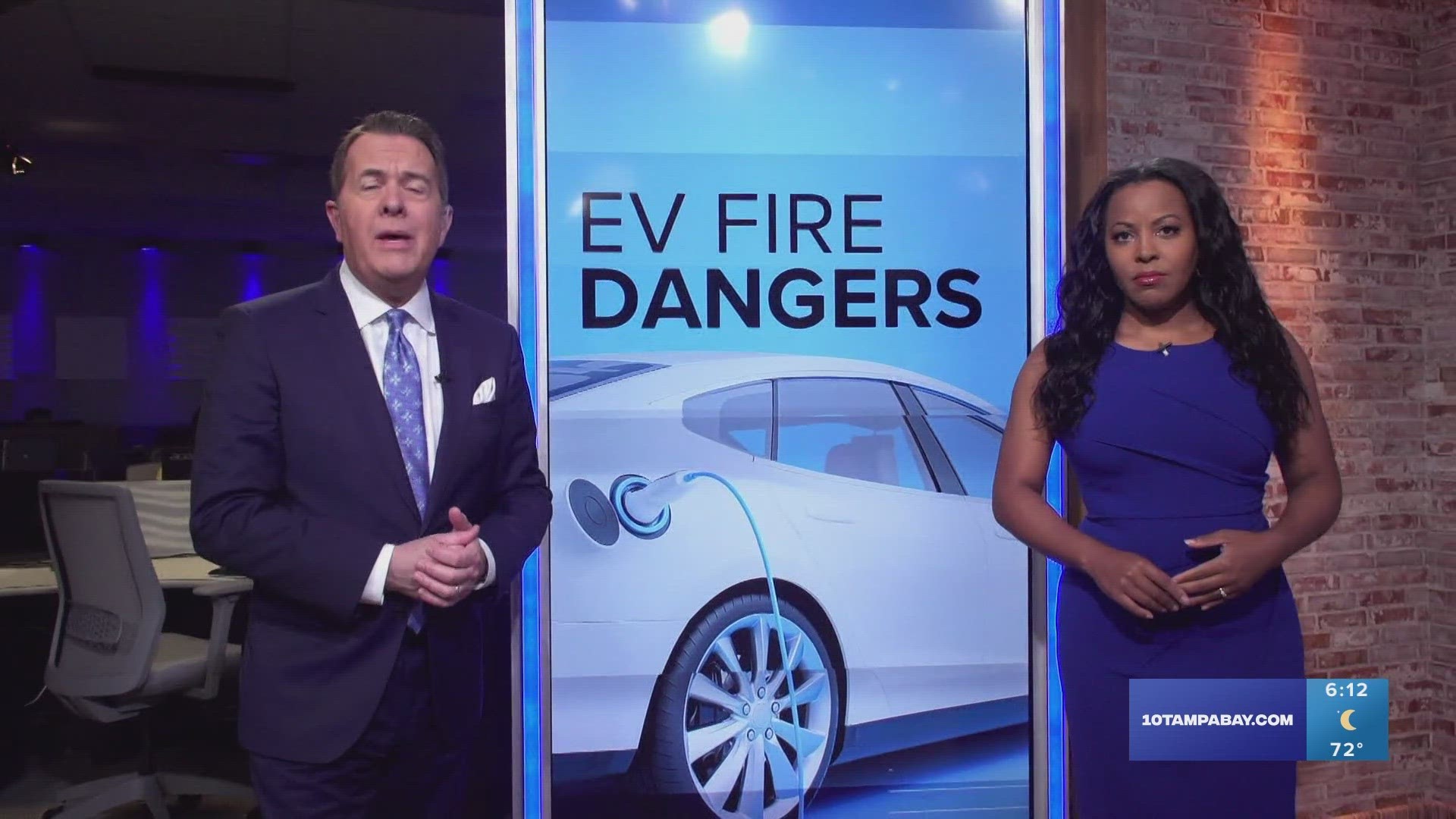PINELLAS COUNTY, Fla. — If your electric vehicle is submerged in saltwater flooding, it is a fire hazard. That is the dangerous lesson learned in the hours and days after Hurricane Ian made landfall in 2022 and again in 2023 following Hurricane Idalia.
There were 20 electric vehicle battery fires related to damage from Hurricane Ian and three related to Hurricane Idalia, according to Florida CFO Jimmy Patronis who oversees the State Fire Marshal’s Office.
Two of the fires after Idalia happened in Pinellas County.
An electric vehicle caught fire outside of a business in Dunedin after saltwater flooded the battery. Surveillance video showed smoke as the first sign, then you could see the extreme heat melt the tires followed by flames. Palm Harbor Fire Rescue responded and kept the fire from spreading.
The next morning, another electric vehicle ignited on the back of a tow truck in Pinellas Park. The driver unloaded it as flames erupted.
“It was pretty impressive,” said Pinellas Park Firefighter Dan Schultz, who responded to the scene.
Schultz says it was his first experience witnessing an EV lithium-ion battery fire. He got there after the initial attack and said the charred frame continued to smolder as his fellow firefighters kept water on the battery.
Training Division Chief T.J. Layfield with the Pinellas Park Fire Department walked through how EV lithium-ion battery fires differ from fires in gas-powered vehicles.
“With electric vehicle fires, it is tough because the thing that’s actually burning is underneath the vehicle and we can’t get to the battery pack,” Layfield said.
Layfield attributes it to a chain event called thermal runaway. According to experts with the NTSB, saltwater corrodes a battery cell, emits energy, heats up and moves to the next cell.
To stop, it must cool and that also takes water.
“On a typical vehicle fire, you can have that thing out in 100-200 gallons. If you have an electrical vehicle fire, you’re going to need a water source. You’re gonna need a hydrant because it’s going to take thousands,” Layfield explained.
Even with those efforts, there is no guarantee it won’t reignite. Southwest Florida firefighters sounded the alarm after electric vehicles reignited on tow trucks or much later in a junkyard.
Patronis was in Southwest Florida after Ian’s landfall and witnessed firefighters battling a tesla blaze on a normally busy road in North Collier County.
Firefighters cut into the engine trying to get to the battery pack. They were on the scene for hours to make sure it wouldn’t reignite.
Florida even created an area for flooded electric vehicles to be placed 50 feet apart in all directions to make sure if they did combust, nothing else would catch fire.
Currently, there is no uniform tracking system for electric vehicle fires at a state or federal level.
UL Solutions developed a global lithium-ion battery incident tracker. Pulling data from firefighters, news reports and other sources, the tracker shows that globally in 2023 there were 139 fires. EV incidents resulted in 118 injuries and 89 deaths.
Almost 209,000 all-electric cars are registered in Florida. That’s a little more than one-percent of the state’s 17,005,490 cars.
Florida is not officially tracking fires related to hurricanes.
“The whole purpose of this legislation is to create a framework to track them all,” said Patronis.
Patronis is supporting DFS Agency Legislation that authorizes the State Fire Marshal’s office to create rules and regulations regarding lithium-ion batteries in cars and smaller electric vehicles such as scooters, hoverboards and golf carts.
“I think as long as we start to collaborate and bring that data together, we’ll see a pattern. We’ll see best practices,” said Patronis.
Chief Layfield says right now it’s really up to the owner to prevent fires related to storm surge flooding.
“I would just evacuate when you’re told to evacuate. And take your EV with you,” he said.
Layfield says if you’re in flood-prone areas, move your electric vehicle to higher ground or at the very least make sure it is not in your garage and is well away from your house and neighbors.
If your electric vehicle is submerged, it needs to be checked by the dealer or a certified technician before you ever try to drive it.

